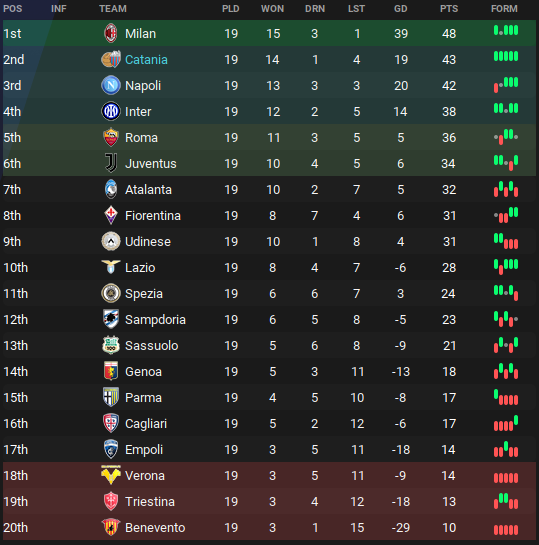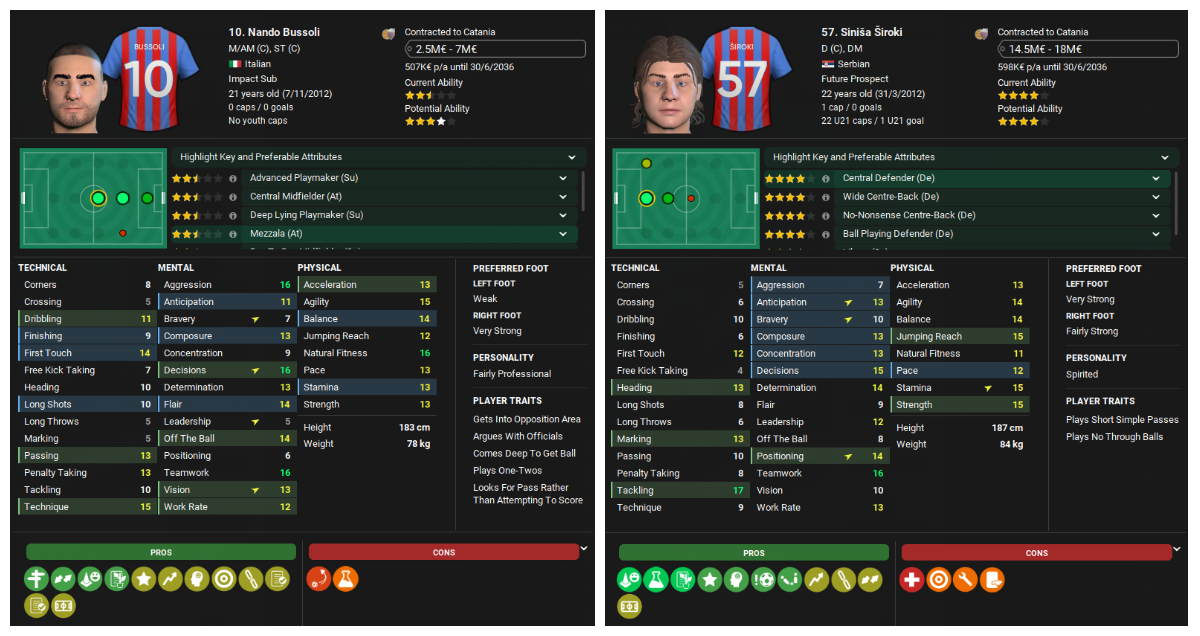Welcome back to “Casual Calcio”!
In episode three, Calcio Catania’s first season back in Italy’s top-flight, the 2032/33 season, was summarized. This episode covers the following season and focuses on Jens Richter’s busy time in the transfer market as well as Catania’s performances in Serie A, the Coppa Italia and the Europa League.
The Croatian-Serbian Revolution And More (Transfers)
Ahead of the season, Jens Richter was equipped with a sizeable transfer budget for the first time in his more than 13-year-long career. More precisely, he was given 24M€ to work with by the Catania board alongside a wage budget that almost had double the size of the club’s previous annual wage budget, which was about 9M€ p/a.
The rules around signing non-EU players in Italy were – and still are – a bit confusing for Jens Richter. Naturally then, he had already wasted the only non-EU slot that was made available to him for this season before he was even made aware of the fact that he’d be limited to a single non-EU player. That was thanks to a pre-contract agreement with an English midfielder who was shipped out of the club again within 6 months of his arrival in Catania due to a number of underwhelming performances.
This absolute masterclass by Richter meant that any further player signings would be limited to players with European passports. Unfortunately, players from most areas of Europe come with a hefty price-tag on their head, so his options were limited even more so. Pretty aware of his situation, Jens Richter immediately sent his scouts to Eastern Europe and told them to look for promising youngsters. To his surprise, that scouting mission went rather well and the scouting department discovered a handful of gifted youngsters who were both affordable and also willing to join a club like Catania before making the step to one of Europe’s elite clubs.
This is where the Croatian-Serbian revolution started. In Josip Eres (20) and Dante Zeljkovic (20), two young Croatians were already at the club. During the 2033/34 season, they were joined by three further compatriots and also by four Serbians. Both countries do have an unpleasant common past, but Jens Richter strictly believed – and also still believes – in the power of football to unite people from all possible backgrounds and this case was no different for him. Further arrivals included players from Belgium, France, Germany, Greece, Italy, Spain, Portugal and Ukraine, so the squad definitely isn’t lacking diversity anymore.
If it hasn’t become clear by now, the Catania squad underwent as massive overhaul during the 2033/34 season. A total of 25(!) players joined Catania during that period, with only two of these being loan signings. In return, 18 players left the club, this time including four players who went out on loan. The total expenditure amounted to 49.5M€, though more than half of that is to be paid in multiple annual installments. The total transfer income was at 26.5M€ with last season’s arrivals L. Torrero (21, sold for 9.5M€) and A. Bogdan (22, had his 6M€ release clause triggered) being the biggest sales by some distance.
Out of the 25 signings, twelve ended up making at least 15 appearances for Catania in their debut campaigns. Due to these numbers – both in terms of signings overall and also the playing time they got – it is barely possible to introduce all of them in detail especially not without spoiling too much about how the season went. Therefore, the key characters are introduced in the following sub-chapters of this blog and potentially also in future episodes of this series.
What If … ? (Performances)
Catania enjoyed a good start to the season, losing and drawing only once in their first nine competitive matches, including both Serie A- and Europa League group stage matches. October saw them fall to three consecutive defeats, so Richter felt like he needed to make some further tweaks to the 4-3-3 he had established last season. These changes mainly affected the roles of the defensive midfielder and the two central midfielders as they previously weren’t doing as well together as Richter thought they could.
Two further defeats followed in November, but other than these six defeats and that one draw, Catania had won all of their competitive matches up to the mid-way point of the season, meaning that they sat in 2nd place in Serie A after 19 matches, five points behind AC Milan – the only team they had drawn with so far. That gap could’ve been just two points if only Nando Bussoli (22) – one of this season’s many signings – wouldn’t have missed a penalty in the fifth minute of added time in Catania’s 1-1 draw away against Milan early on in the season.
Furthermore, Catania secured 2nd place in their Europa League group as they finished behind RB Leipzig but ahead of Sturm Graz and Dinamo Zagreb. The group’s outcome could’ve looked a lot different as Catania were 2-0 down in only the second group stage match away against Zagreb before mounting a comeback of epic proportion. Giovanni Cerino (19), yet another new signing, bagged a hat-trick in the second half with two of these goals even coming after Catania had gone down to ten men and thus secured an unlikely 3-2 to win for the away side. Up until that match in late September, Cerino was exactly what he was meant to be when Richter brought him in from Serie B-side Modena for a club-record 12.5M€ on deadline day of the summer transfer window – the backup to Catania’s star striker Emilio Taurone (27) with the potential to one day replace him. From that match onwards, however, Taurone steadily saw his appearances in the starting eleven decrease in favour of the young Italian U21-international.
For the most part, Catania managed to keep their impressive form up for the second half of the season. Still, some likely complacency-led draws and losses against bottom-half sides saw them drop points in underwhelming fashion fairly regularly. Despite these slip ups, a 2-1 win over Roma on matchday 31 even meant that they took over 1st place from AC Milan, who seemingly were unable to replicate their form from the first half of the season in the second half. By that point, Catania had made it past the round of 32 of the Europa League thanks to a 4-0 aggregate win over Olympiacos, before dropping out at the quarter final stage due to a fair 1-0 aggregate loss against Brighton. Richter’s side also exited the Coppa Italia in the semi-finals thanks to an entirely undeserved 7-1 aggregate score line in favour of Inter.
Going into the final five Serie A games of the season, the two horse race between Catania and Milan was very much on as the former were only one point ahead of Milan.
Both Catania and Milan had similarly looking run-ins and whilst Catania won their first two of these final five games, Milan only won one and drew the other, extending the points-gap between the two sides to four points with three games to go.
Then, on matchday 36, Catania also slipped up as they drew 1-1 against a Fiorentina-side who sat mid-table and had nothing to play for. The worst thing about this? Well, it’s either the fact that they were unable to keep up their four point lead at the top of the table as Milan won their match and thus closed the gap to just one point again OR it was because of the way they conceded Fiorentina’s only goal of the match. I mean, look at THAT howler by Catania’s new number one goalkeeper Sreten Derovic (17)…
The Fiorentina result and the way it played out had an obvious effect on the Catania players as they were also unable to beat Juventus, a side which they had massacred 5-0 at home earlier on this season, in the next match. The match ended 2-2 and as if THAT howler in the previous match wasn’t bad enough, it was an own goal by a Catania defender which eventually ended up gifting Juventus a point…
Thanks to these two entirely unnecessary draws (alongside the other nine Serie A matches Catania were unable to win during the season) – you probably guessed it already – Catania gave away 1st place with only one match to go. Milan was “only” one point ahead of Catania going into the final game but with Milan facing already relegated (and rock bottom of the league) Benevento, there was little hope for Catania. But a little bit of hope is better than no hope at all and Catania found themselves top of the table again at half time, thanks to Benevento keeping the ball out of their own net for the time being and Catania leading 1-0 against Parma. That slight bit of hope was quickly crushed as the floodgates in Benevento opened shortly after the restart. Milan scored four within the first 17 minutes of the second half and later even added a fifth, meaning that there would be no Serie A title for Catania this season.
In theory, not winning their first Serie A title just two seasons after getting promoted to the Italian top-flight again shouldn’t bother Catania too much, but basically throwing away the title the way they did came as a crushing blow to the club’s fans, players and staff, including Jens Richter. Incredibly, they felt like they should’ve done better despite recording the club’s highest ever finish in Serie A in its 72 year long history. That feeling was further reinforced by the infamous xG-table, which revealed that Catania should’ve won the title if it wasn’t for AC Milan outperforming their expected points total by 14 points compared to Catania, who themselves “only” outperformed theirs by ten points. In this sea of dissatisfaction, there is at least one positive: Catania qualified for the Champions League group stages for the first time in the club’s history. If nothing else, this will provide some additional income and it should also boost the club’s reputation.
What sticks are the endless ‘what if’-questions. What if Richter’s side wouldn’t have drawn 0-0 against relegation-threatened Triestina mid-season? Or what if they hadn’t lost to Sampdoria and Udinese early on in the season or simply dropped two points less overall? And most pressingly of all, what if goalie Sreten Derovic had kept his calm in THAT moment against Fiorentina on matchday 36 and just cleared the ball anywhere but into the opposing striker’s legs?
Players Of The Season
As pretty much always at the end of the season – at least for the past three seasons including this one – the Croatian “twins” Josip Eres (20) and Dante Zeljkovic (20) ended up being Catania’s best players. Eres has increased his attacking output once again, scoring nine goals and providing 16 assists, compared to eight goals and ten assists last season. Meanwhile, Zeljkovic scored one goal less than last season but four goals in a season are still very good for a central defender. The level of his defensive performances is probably best reflected by the 7.35 average rating that he earned himself over 31 appearances.
Emilio Taurone (27) is another player who already featured in this section last season and who does so again this time around. Whilst his starting eleven appearances decreased compared to last season, he was still able to score 17 goals and provide three assists in 26 appearances. In Giovanni Cerino (19), the reason why Taurone‘s starting eleven appearances decreased also features in this list. In an impressive debut campaign, he contributed 22 goals along with three assists in 38 appearances.
Despite being one of the tragic heroes of this season due to his penalty miss in Catania’s draw with Milan during the first half of the season, Nando Bussoli (21), had a great first season in Catania. Like Cerino, he joined Catania from Serie B this season, in his case from Perugia and for a fee of 2.2M€. He mainly played as either an attacking-minded central midfielder or as a similarly attacking Mezzala and was directly involved in 21 Catania goals (12 goals | 9 assists) in his 37 appearances.
In Sinisa Siroki (22), Jens Richter picked up an absolute gem of a central defender on a free transfer during the summer transfer window. The highly regarded Serbian prospect rejected a contract extension at his boyhood club Partizan last season because he felt like he had outgrown them. Unfortunately for Siroki, he broke his ankle just ahead of the 2033/34 pre-season and the previously interested big clubs from across Europe dropped their interest in his services. That’s where Jens Richter came in and offered him to spend his recovery period at Catania with the opportunity to go on trial with them once he had fully recovered. Siroki jumped at the opportunity (figuratively, at least…) and following said trial, he was offered a contract by the club which he happily accepted. He paid back Richter’s trust in his abilities by averaging a 7.3 rating across his 27 appearances and even found the opposing net on three occasions.
Finances
Catania’s finances are in great shape for the time being thanks to the 57.5M€ they received for Serie A TV rights, the 23.5M€ Serie A prize money for finishing 2nd and also the 8.5M€ that were generated from their Europa League participation. The main source of expenditure, next to transfer fees, were the player wages at 16.73M€ which still is the lowest wage bill of any Serie A-side, though this season by about 4M€ per annum. By comparison, Juventus, who themselves ended up finishing 4th, spent 242M€ on player wages this season. All in all, Catania’s overall balance currently sits at about 80M€ pre-tax.
The Summer Ahead
The question where Catania go from here is one that can only vaguely be answered once the upcoming summer transfer window is shut. That’s because a(nother) summer of wheeling and dealing is about to kick off as countless release clauses of players from Catania’s first-team seem to be on the verge of being triggered by more reputable clubs and a few of the players in question are not really interested in extending their contracts at the time of writing, with Josip Eres being just one of them. The latter is by now home-grown at club and therefore of utmost importance to the club, especially with regards to his on-pitch performances and European registration rules.
Catania should be able to compete at the top-end of Serie A next season if they manage to hold onto most of their key players or at least put the available transfer budget of 24M€ and the additional wage budget of 10M€ p/a to good use and replace them with players of equal or – ideally – better quality. In case Jens Richter and his staff are unable to do so, Catania might be in for a rollercoaster of a season next time around.
Whatever the outcome of the upcoming summer is, you’ll find out about it in the next episode of “Casual Calcio”. 😉

That’s it for the fourth episode of “Casual Calcio”. I hope you’ve enjoyed reading about my – or from a narrative POV Jens Richter’s – misery and would love to welcome you back next time (whenever that may be)! – Oaky










One thought on “Casual Calcio | #4 | Of A Revolution And ‘What If’-Questions”